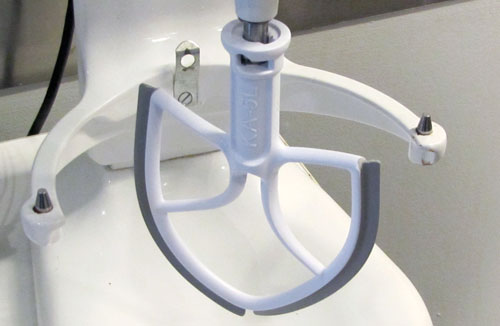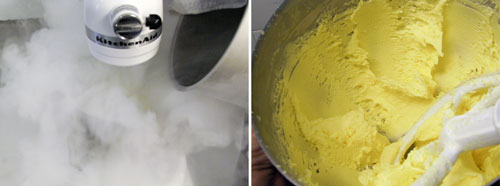posted by Dave Arnold

Salep dondurma is a variety of Turkish ice cream prized for its stretchy, chewy nature. The stretch and chew comes courtesy of  salep, the powdered root of a rare Turkish orchid. It is illegal to export the powder from Turkey, so folks (including us) have come up with fake salep recipes with legal ingredients. We posted on it here: Fake Fryable, Brûlée-able Salep Dondurma Ice Cream.
Yesterday, by accident, we came up with our easiest and favorite chewy ice cream yet. We like it better than the real salep. Plus, it is made from potatoes! The story includes an equipment review, some luck, and some celebration. Chewbacca isn’t really in the post.
This post was supposed to be an equipment review of the Beater Blade

The Equipment Review:
The Beater Blade is a hard plastic paddle with rubber scrapers on its sides – so you don’t need to scrape the the bowl while you are using a stand mixer. Our pastry department loves it; they even claim it makes their cakes rise higher. I just wanted to know whether it would make a better liquid nitrogen ice cream.
When making liquid nitrogen ice cream in a Kitchen-Aid it’s very easy to partially over-freeze, to bad effect. A crust of frozen ice cream forms on the inside surface of the bowl and isn’t removed by the standard paddle –you have to scrape it off by hand. You are left with ice cream that is too hard in some places and too soft in others. I figured the BeaterBlade would either solve that problem entirely or shatter into tiny pieces because liquid nitrogen, plastic, and rubber don’t always play nicely together. We tried it yesterday and it works beautifully:

We haven’t broken the paddle yet. Someday we will.
Dumb Luck:
We were done with the equipment review. We were cleaning up. Sitting on the table were some leftover potatoes that we had steamed for another experiment. Just big old hunks of cold steamed russet potatoes –dry, fluffy, mealy.

We were in a bit of a silly mood, so I said, “hey, blend some of those potatoes into the ice cream base.†We Vita-Prepped enough potatoes into the vanilla ice cream base to make a gluey batter. We put the batter into a Kitchen-aid fitted with the BeaterBlade, hit it with LN and, to our great surprise, it became super-stretchy, super-chewy, super-smooth, super-easy ice cream.

In case you want to know what happens around here when we discover something new:

I did my happy dance, which wasn’t appreciated because the students next door were taking a final. I just couldn’t help myself.
I don’t have an exact recipe yet. Just make sure the ice cream base has a lot of flavor and a lot of sugar, because you will add a lot of potato. You don’t need the LN either, just make this  however you normally make ice cream.

How does the BeaterBlade compare to the SideSwipe, which is made for the same purpose but has a different design?
I will stay tuned for more potato details.
Dunno Paul A., I haven’t used the SideSwipe.
I haven’t used the BeaterBlade, but I have a SideSwipe, and I make LN2 in my KitchenAid (tilt-head) on a semi-regular basis. I like it. It does what it’s supposed to do. Not sure if it’s better or worse than the BeaterBlade.
Er, I meant LN2 *ice cream*, of course.
awesome….there must be a way to isolate those gluten proteins and add them to the ice cream…what’s a pure gluten source….???
….well i stand corrected, potaoes are gluten free….guess we need to look at potato starch….
Yeah, but the question is, would gluten also be really cool?
Since most of the protein in potatoes is contained right under the skin, why not try a controlled experiment and do 3 rounds of ice cream, one with steamed peels or at least the outer layer, one with middles and a control from the same method you just used? Would be interesting to see what differing amounts of starch and protein would do to the structure… Also, you may be able to reduce the amount of potato you put in and not have to add so much sugar…
Also, how much resistance does the ice cream give in the ice cream maker? i only have a small countertop one and i don’t want it to suffer death by elasticity.
Dunno Mellor, It does get mighty elastic.
This is mind blowing. I’m looking forward to seeing what you all do with this new discovery. I can’t wait to try it.
Wow! I’ve never seen ANYTHING like this. How crazy!
I have done a potato ice cream using potato starch that has a very awesome feel…that to think if we add more potato starch it may do the same. the ice cream base with the starch definietely thickens and has a elastic viscosity to it.
I think a cool experiment would be to make the ice cream using high amylose starch (linear polymer chains) versus high amylopectin starch (branched polymer chains). My guess is that high amylose is the optimal starch for optimal stretch.
Another notable characteristic of salep ice creams is resistance to melting. I thought this could be used to make a high alcohol ice cream that would stay frozen. I made a salep ice cream with a Lebanese instant sahlab mix and whole milk. I froze it with liquid nitrogen while paddling in a stand mixer. I threw in a bunch of dried cherries and a boat load of high octane kirsch. It packed a whallop and stayed frozen overnight in my kitchen freezer. I call it the KirschBomb Brain Freeze.
I’d be interesting in seeing a potato starch version compared to a version made with pure potatoes.
I’m going to try making this tomorrow night…what kind of ratio of potato to ice cream base did you use? I assume I shouldn’t be afraid of overmixing the potato, since I’m trying to get to a gluey batter anyway.
I will post the recipe tonight or tomorrow morning.
The french have known for some time how to make potatoes stretch and cooks illustrated provides a recipe how to make stretchy mash potatoes, aka aligot.
http://www.cooksillustrated.com/recipes/article.asp?docid=18914